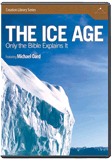First conference on creation geology
The First Conference on Creation Geology gave researchers the opportunity to share their research and receive comments to better their efforts.
[Editor’s note: It is a great time to be a Christian! With the creation movement pointing people back to the authority of the Word of God, many fields of science are increasingly reaping the benefits. Geology is no different. The First Conference on Creation Geology, held July 26–28 at Cedarville University, gave researchers the opportunity to share their research and receive comments to better their efforts.]
Creation geology education
The theme for this conference was Geology Education for the Future, chosen to coincide with the presentation by Associate Professor of Geology at Cedarville University, Dr. John Whitmore, of details for the university’s proposed new bachelor of science geology major to be launched in the Fall of 2008 once all the necessary approvals have been obtained and building space provided. The geology courses in the proposed program include: Introduction to Physical Geology, Historical Geology, Mineralogy, Geomorphology, Invertebrate Paleontology, Petrology, Structural Geology, Philosophy of Science and Research Methods in Geology, Environmental Geology, Stratigraphy, and Sedimentology, and a summer field camp, senior project, and various elective courses.
To complement these, this rigorous and well-rounded degree will also require courses in biology, chemistry, calculus, and physics, along with all of the general education requirements of Cedarville University, such as a Bible minor. To fully implement this geology major will, in time, also require the hiring of new geology teaching staff. This is indeed an exciting development which aims to produce geology graduates thoroughly grounded and trained from a biblical creationist perspective who can then enter secular university geology programs for graduate and terminal degrees.
It has been recognized for some time that the ranks of professionally-trained geologists with terminal degrees in the creationist community are thin and aging, so as a movement we need to see the ranks expand with younger Ph.D. geologists to whom the torch can be passed. Cedarville University is to be congratulated for their vision for this geology program and their drive to make it happen. I, for one, will look forward to hearing at next year’s Second Conference on Creation Geology that this geology major at Cedarville has begun with its first classes!
The technical sessions
The first two days of the conference were for technical presentations covering the full gamut of subdisciplines within geology. Each presentation lasted for 30 or so minutes and was followed by questions and discussion. These technical presentations included:
- Advances in igneous and metamorphic geology from a creationist perspective using <radiohalos (Dr. Andrew Snelling of AiG).
- Dinosaur distribution within the context of biome succession (or why are dinosaurs restricted to the Mesozoic?) (Dr. Lee Spencer of Southern Adventist University).
- Creationist solutions to the “reef problem” (Dr. John Whitmore of Cedarville University)
- Crossbed genesis and the Coconino Sandstone ichnites (Ian Juby)
- Hardgrounds as a challenge to Flood geology and a young earth (John Woodmorappe)
- Building consistency: An educational model for promoting a biblical creation worldview (Dr. Marcus Ross of Liberty University)
- Cold-blooded metabolism and changing oxygen levels resulting in a new hypothesis for dinosaur extinction (Dr. Timothy Clarey of Delta College, Saginaw, Michigan)
- Rotational tumbling of the earth induced by catastrophic plate tectonics: The resulting mega-tsunamis (Dr. John Baumgardner of ICR)
- Continental scale megadrainage from DEMS and satellite imagery: Implications for Ice Age flooding (Dr. Peter Holyland)
- Flood/post-Flood boundary in the late Cenozoic western US (Michael Oard)
- Mercury and the Genesis Flood: A response to Morton (Dr. Aaron Hutchison of Cedarville University)
- An examination of 129Xe and 14C in carbon dioxide gas wells (Dr. John Doughty)
- Contribution of Paleozoic sediment isopach patterns to a Flood model (Dr. Lee Spencer of Southern Adventist University)
- Spiraling polystrate plants in the Joggins Formation, Nova Scotia: Evidence of rapid deposition of megaformations and rapid continental movement (Ian Juby)
A few technical session summaries
Order in the fossil record
The order of the fossils in the geologic record is real and has been a vexing issue that has taxed creationist geologists for more than two centuries, so the presentation of a model for why dinosaurs are restricted to the Mesozoic was welcome. In doing so, Dr. Lee Spencer endeavored to justify and elaborate on the ecological zonation model as first proposed by Harold Clark in 1946.
If we look at the life/ecology zones in the living biology today across mountains, such as the Sierra Nevada of California, or in a traverse from the South Rim of the Grand Canyon down to the Colorado River, we notice that there are distinct plant and animal communities that are characteristic of the climate at different elevations. Thus, we observe cacti growing in desert zones and pines growing in alpine zones. Just as these life/ecology zones today can be correlated globally (all deserts around the world have similar plants and animals), so too, Dr. Spencer demonstrated, the fossil zones and fossil communities can be correlated globally within the geologic record. Thus, the ecological zonation model for the order of fossils in the geologic record would argue that the lower layers in the record must therefore represent the fossilization of biological communities at lower elevations and warmer climates, while higher layers in the geologic record must represent fossilization of biological communities that lived at higher elevations and thus cooler temperatures.
Dr. Spencer then argued that the mammals in the upper layers of the geologic record must have lived at higher elevations and cooler temperatures, since body temperature regulation today in animals correlates with the zones in which animals live—this could equally be applied to the fossil record. While humans generate their own body heat because they are warm-blooded, modern reptiles get much of their body heat from the environment (e.g. lying out in the sunshine). Thus, modern-like mammals and dinosaurs (which were reptiles) would not have lived in the same environments in the pre-Flood world, and so, we don’t find them fossilized together (dinosaurs are primarily found in Mesozoic strata, whereas modern-like mammals are only found higher in Tertiary strata).
Dr. Spencer concluded by arguing that the extinction of the dinosaurs does not require a large meteorite impact, but only the biblical Flood, because, in the post-Flood world, there likely would have been no conducive climate for the dinosaurs to live in. In the question time following, it was suggested that altitude was more important than latitude for the pre-Flood climate zones and therefore biological communities. Thus, as Dr. Spencer had argued, the order of fossil “succession” in the geologic record would reflect the successive burial of these pre-Flood biological communities as the Flood waters rose up on to the continents.
Post-Flood reefs
Another apparent vexing “problem” for Flood geology is the claimed fossilized “reefs” in the geologic record. Dr. John Whitmore highlighted that the coupled “problem” is whether there was enough time since the Flood for large modern reefs to grow to their current sizes. The thickest modern reef is Eniwetok Atoll in the Pacific, which at 1400 meters thick would have been difficult to have grown since the Flood at modern maximum coral growth rates of between 99 and 432 mm per year. It is because of the time required for such reefs to grow that the claimed in situ fossil reefs in the geologic record are cited as a problem to Flood geology.
However, whereas modern reefs are typically large frameworks of coral and algae growing on their dead predecessors, fossil reefs are often not made of corals, are orders of magnitude smaller, and often lack a framework. Indeed, many ancient “reefs” are unorganized piles of carbonate debris that therefore could have accumulated during the Flood, microbial carbonate production subsequently providing loosely bound frameworks to these “structures.”
Another suggestion is that some of these so-called ancient reefs could have been pre-Flood reefs that were, during the Flood, ripped up, transported, and reburied in the strata in which they are now found. Most modern reefs, Dr. Whitmore pointed out, can be accounted for as having grown in the 4,300 years since the Flood at modern measured maximum growth rates. Furthermore, even the growth since the Flood of the problematical Eniwetok Atoll can be explained once it is recognized the reef has grown on top of a former volcano. The heat from the dying volcano as it sank with the sagging seafloor beneath it would have encouraged corals to grow on top of it due to water and nutrients being drawn into the growing carbonate reef in a process known as geothermal endo-upwelling. This would have caused the corals to grow faster near the ocean surface on top of the thickening carbonate platform sitting on top of the sinking former volcano with its residual heat driving these processes since the Flood.
Polonium radiohalos
A hydrothermal fluid transport model has been proposed for the generation of polonium radiohalos in biotite (black mica) flakes. This model envisages the polonium isotopes being sourced from the radon and polonium produced by uranium decay in the zircon inclusions at the centers of closely adjacent uranium radiohalos in the same biotite flakes—the hydrothermal fluids generated as granitic magmas crystallize and cool transporting the radon and polonium as the fluids flowed along the cleavage planes between the biotite flakes. The polonium nucleated and concentrated at lattice imperfection sites which became the radiocenters for generating the polonium radiohalos below 150°C, the annealing temperature of radiohalos.
Because of the very short half-lives of the three polonium isotopes, polonium radiohalos had to form exceedingly rapidly, but as I have pointed out, because there has to be sufficient polonium left after the granitic magmas had crystallized and cooled below 150°C, this places a 6–10 day time limit for the crystallization and cooling of the granitic magmas themselves. In my presentation, I then showed how this hydrothermal fluid transport model for polonium radiohalo generation has now been tested in numerous geologic settings. Where more hydrothermal fluids were generated in the regionally metamorphosed sandstones in the Great Smoky Mountains, Tennessee, more polonium radiohalos were found.
Similarly, where hydrothermal fluids penetrating along closely spaced shear zones in high-grade metamorphic rocks had transformed them into another metamorphic rock, polonium radiohalos are found. In the Cooma Metamorphic Complex of southeastern Australia, where clay-rich sediments have been regionally metamorphosed and partially melted at the highest grade in the center of the complex to produce an in situ granite, the polonium radiohalo numbers are found to progressively increase with increasing grade to where hydrothermal fluids were most active in the regional metamorphism and the formation of the granite.
Further confirmation of the model is found where polonium radiohalo numbers are drastically reduced in the partial melting zone, because there the hydrothermal fluids were less as a result of water going into solution in the granitic melt. I also showed how polonium radiohalos can be used to resolve seeming problems for creationists in metamorphic and igneous geology. Even though the Shap Granite, England, intruded into fossiliferous host rocks during the Flood, the presence of polonium radiohalos in this granite indicates the Flood timescale was not a problem for this granite to have crystallized and cooled, as well as the heat and hydrothermal fluids from the granite metamorphosing the surrounding host rocks.
And finally, increasing numbers of polonium radiohalos in the four concentric, nested granitic bodies of the Tuolumne Intrusive Suite in Yosemite National Park is consistent with the increasing hydrothermal fluid content of these progressively intruded granite bodies, culminating in a violent volcanic eruption above them. The timescale for these polonium radiohalos, and therefore the intrusion of all four granite bodies, would only amount to a few weeks.
Earth rotational instabilities during the Flood
In seeking a mechanism for transporting huge thicknesses of sediments onto and across the continents during the Flood, Dr. John Baumgardner reported on his modeling of rotational instability of the earth induced by catastrophic plate tectonics. If there was a pre-Flood supercontinent positioned roughly over today’s South Pole that broke up at the beginning of the Flood, and paleomagnetic data for that reconstruction is tenuous, this implies 90° of true polar wander occurred during the first few weeks of the Flood to produce the subsequent supercontinental configuration of Pangea. To achieve this would have required the earth to be rotationally unstable, perhaps due to mass movement of plumes within the mantle as a result of catastrophic plate tectonics.
Dr. Baumgardner then reported on his numerical modeling of the gyroscopic motion of a freely rotating body such as the earth with its continents, and showed that this produced multiple rotations of the original pre-Flood poles. The effect on the water of the oceans would have been to produce tsunami-like 50 meter high waves that flooded over the continents at a velocity of 60 meters per second, capable of producing large-scale uniform sedimentary deposits. He also concluded that this rotational tumbling of the earth, which included the mantle, could potentially account for the claimed magnetic pole reversals. It will be interesting to hear further reports on this modeling work in the future to see if these initial conclusions are fully warranted.
Mercury pollution during the Flood
The well-researched presentation on mercury and the Genesis Flood was made by Dr. Aaron Hutchison in response to old-earther Glenn Morton who has argued that mercury pollution released by the Flood would have been sufficient to threaten the re-establishment of life on the earth. However, with a Ph.D. in organic chemistry primarily focused on mercury chemistry and remediation, Dr. Hutchison ably dispensed with Morton’s deeply-flawed arguments, which are based on incorrect estimates of the modern crustal mercury concentration and his lack of understanding of the biogeochemical cycle of mercury, including its toxicity. However, it is true that volcanic activity and leaching would have resulted in a higher than normal mercury concentration in the waters of the Flood, and that most of this mercury would have found its way into the sedimentary rock layers being deposited, particularly coal beds and black shales. Further research will continue on mercury distribution in the geologic record as a guide to which strata were Flood deposited.
Technical meetings such as those held at this conference provide ample opportunities for discussions, which continue on into the breaks and the evenings. It’s an opportunity to renew friendships and turn acquaintances into friends, which helps to make sure that discussions on points where there are disagreements remain cordial. Networkings for future research collaborations are also made. The timing of presentations also allows for researchers to test their ideas ahead of full-scale publishing of them, as creation geologists continue to focus their efforts on producing a coherent model for the Flood that explains not only the big picture of the rock record of the Flood, but also the details.
Field Trips
Two evening field trips were held to local sites of geologic interest. The first was to Caesar’s Creek State Park at Waynesville to see claimed hardgrounds in the Ordovician limestone outcropping there, which also contains numerous brachiopods, bryozoans, trilobite, and other invertebrate fossils.
The second-evening field trip was to the Indian Mounds Reserve just west of Cedarville, where a creek has cut a deep gorge exposing the Silurian Cedarville Dolomite and the strata units below it, including the Massie Shale. Interestingly, these dolomite and shale units directly correlate with the dolomite that forms the lip of Niagara Falls, and the shale that is being eroded underneath by the waters of the plunge pool, demonstrating that these sedimentary units cover vast areas, as would be expected by the waters covering the continent during the Flood.
General sessions
All of Saturday, July 28, was devoted to general presentations that were open to the lay public to attend. The seven presentations were:
- Creationist geology in Grand Canyon (Dr. John Whitmore of Cedarville University)
- The creationist Ice Age model and global warming (Michael Oard)
- Geological aspects of the AiG Creation Museum (Bodie Hodge of AiG)
- Radioisotopes on a young earth (Dr. Andrew Snelling of AiG)
- Twelve years in Athens: A creationist’s journey in geological education (Dr. Marcus Ross of Liberty University)
- Science, dinosaurs and Hanson Research Station (Dr. Lee Spencer of Southern Adventist University)
- The housing and care of the cargo on Noah’s Ark (John Woodmorappe)
A few general session summaries
Dinosaur excavations utilizing GPS
The presentation by Dr. Lee Spencer on the excavation of a dinosaur bone bed at the Hanson Research Station in central eastern Wyoming showed how creationist research can be at the cutting edge of both technology and science. The excavation team is using satellite-based global positioning system equipment to record the locations of every bone recovered from this bone bed, which consists primarily of the disarticulated bones of countless duck-billed dinosaurs (hadrosaurs).
Each of the bones is also photographed, so that the digital images can be uploaded to geographic information system (GIS) software in computers. When combined with the GPS positional data, this means that the original positions of the bones in the bone bed in the ground can be reconstructed. Then using the computer program, the distribution of bones in different levels in the bone bed can be investigated and displayed pictorially. Details of this excavation technique have been presented at leading conventional scientific conferences and applauded for being innovative, even though the excavation team is openly creationist. The good news is that laypeople are welcome to join the excavation team in June each year to help in this research.
A creationist studying in secular higher education
A highlight for me at this conference was the presentation by Dr. Marcus Ross of his experiences and what he learned from them in his 12-year journey earning his bachelor of science degree in earth science from Pennsylvania State University, his master of science degree in paleontology from the South Dakota School of Mines and Technology, and a Ph.D. in environmental science (geoscience) from the University of Rhode Island with a dissertation on the distribution and fate of mosasaurs, a group of large marine reptiles found in Cretaceous deposits worldwide.
Dr. Ross provided sound advice for parents and young potential creation scientists to follow. He entered his university studies as a Christian and a young-earth creationist and faced significant challenges to his faith and his creationist geology position from fellow students and professors, never hiding either his Christian faith or his young-earth creationist position. His testimony showed that it is vital to establish good personal relationships with one’s professors and know when to be more circumspect in one’s witness and in on-campus activities. But even more important, he testified that it is absolutely vital to always maintain a consistent strong connection to a local supportive church fellowship, because there he found the support and nurture that kept him going when times were tough in these secular universities where he studied.
Confirmation of his sound advice was demonstrated earlier this year when upon his graduation from the University of Rhode Island a reporter from The New York Times picked up the story, and when that reporter interviewed staff at that university in order to perhaps find some “mud” to throw at Dr. Ross, the staff only spoke kindly of him and of the quality of his science!
Acknowledgments
Cedarville University is to be thanked for hosting this conference with their excellent facilities, and the Creation Research Science Education Foundation (CRSEF) of Columbus (Ohio) led by Dr. Aaron Hutchison and Dr. John Whitmore is to be congratulated for organizing an outstanding event. Many are looking forward to the next conference in 2008, so be ready and waiting for the announcement! Abstracts from this first conference can be viewed at Cedarville’s website [PDF]. I would encourage all creation geology researchers to start preparing now, as I am sure you won’t want to miss out on the next conference.
Recommended Resources

Answers in Genesis is an apologetics ministry, dedicated to helping Christians defend their faith and proclaim the good news of Jesus Christ.
- Customer Service 800.778.3390
- © 2024 Answers in Genesis







